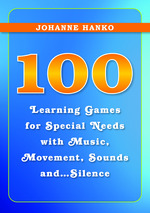 Johanne Hanko, PhD, has over 20 years of experience as a teacher, trainer and capacity building specialist for children and adults with special needs, and has worked in a wide range of countries across North America, South America, Asia and Africa. For over 10 years she was a technical advisor and member of the Thematic Working Group on Disability-Related Concerns for the United Nations’ Economic and Social Commission for Asia and the Pacific. She currently resides in La Paz, Bolivia.
Johanne Hanko, PhD, has over 20 years of experience as a teacher, trainer and capacity building specialist for children and adults with special needs, and has worked in a wide range of countries across North America, South America, Asia and Africa. For over 10 years she was a technical advisor and member of the Thematic Working Group on Disability-Related Concerns for the United Nations’ Economic and Social Commission for Asia and the Pacific. She currently resides in La Paz, Bolivia.
Dr Hanko is the author of the new book, 100 Learning Games for Special Needs with Music, Movement, Sounds and…Silence. Here, she talks about some of the invaluable positive affects that these activities can have on the physical, cognitive, social and emotional development of children with special needs.
You have had a very interesting and varied career. How did you come to work with children with special needs?
It all started when I was in high school; my aunt was working in an institution for children with learning disabilities. One year she brought me to celebrate Halloween with them; I was introduced to the kids, many older than I was, and to the special needs they had. That is when I decided that I wanted to make a difference. As I had been studying music since I was a child, and was interested in psychology and in medicine, I decided to study Music Therapy. This brought me to work with children with various types of disabilities and special capacities, including those with emotional and physical challenges, children with Down’s syndrome and those on the autism spectrum. Then I moved to Thailand and worked for the UN’s Food and Agriculture Organization, first on the capabilities of people with learning disabilities in Thailand and then on skill building and training for persons with differentiated capacities in Asia and Africa.
How did you develop this activities book?
While living in Thailand, during an exhibit of my collection of musical instruments, I held a demonstration of how to use music and musical instruments as a teaching tool for children with disabilities, especially in rehabilitation and in skills development. The Thai children responded extremely well – even better than I had anticipated. Some children were so engaged by the exercise activities that they forgot to use their crutches. As a result, the Ministry of Education asked me to give master classes to teachers from both special education and mainstream school systems as part of their yearly training and pedagogical specialization classes. I used the games I had developed as a tool for the teacher training programme. The teachers loved the games and their adaptability to locally available materials, and to the specific challenges encountered by the children; and so they asked me if I could compile these games in a book that they could use in their teaching programme.
Many of the games in the book use music and movement. How does this help motivate children with special needs to learn?
Every child loves to play, run and dance. The games were designed to use this tendency as a “distraction” from the hard work involved in developing a specific skill or practicing a certain movement, so that the child actually enjoys what he is doing. One example would be a child that has a mobility and/or coordination problem with their arms. Physiotherapy would require the child to practice moving the arms – not enjoyable for a child. However, a game that asks the child to “bang” on a drum strengthens the arms and improves coordination, while offering the incentive – and great pleasure – of hitting the drum and hearing the sound it makes.
Can the book be used with all children, no matter what their particular needs – for example, deaf children? If so, how do the games accommodate this?
Most if not all the games in the book can be adapted to the specific needs and capabilities of each child. When the game indicates a limitation, it usually includes an explanation on how it can be adapted for a specific type of disability. Although it would be impossible to include all the variations in a single book, a good teacher, educator or parent that knows the capabilities of the child would know and understand exactly how to adapt the game.
Regarding the case of hearing impaired children, the reality is that many children can hear something; very few are completely deaf. As such, the vibrations can be partially heard and certainly felt by the body allowing a child to feel and differentiate various types of vibrations through specific activities.
What is your personal favorite game in the book?
 It is difficult to say which one of the games is my favorite since my favorite game is one that gives me a positive and obvious result with a specific child. This being said, I will say that one of my favorite games is “Contemporary Music or Drawing Music” (activity #80, page 103) because I was told not to use this game with children with differentiated capacities nor with mainstream classes because it would lead to failure: “Children in special education and elementary school children cannot compose,” I was told. Well I can tell you this is not true. I was amazed to see the creativity of some of the children, while all came up with something different and interesting; some compositions were quite beautiful. One should never underestimate the capabilities of children with special needs or their creativity.
It is difficult to say which one of the games is my favorite since my favorite game is one that gives me a positive and obvious result with a specific child. This being said, I will say that one of my favorite games is “Contemporary Music or Drawing Music” (activity #80, page 103) because I was told not to use this game with children with differentiated capacities nor with mainstream classes because it would lead to failure: “Children in special education and elementary school children cannot compose,” I was told. Well I can tell you this is not true. I was amazed to see the creativity of some of the children, while all came up with something different and interesting; some compositions were quite beautiful. One should never underestimate the capabilities of children with special needs or their creativity.
Another great game is “Feather Racing” (activity #70, page 92), which allows the child to control breathing. This game is especially useful with Down’s syndrome children who have difficulty controlling their tongue. Initially spitting on the feathers more than blowing, they eventually learn to control their tongue and blow only air, thus improving their speech ability.
What do you hope special education teachers, teaching assistants, parents and carers will take away from this book?
Readers should not use this book as a recipe book but rather, they should adapt each game to their own style and environment, according to the specific needs and capabilities of the children, and to the materials available.
More importantly, readers must enjoy the games along with the children; children enjoy these games and do not see them as learning tools, but rather as play time – unaware of the structure, rehabilitation, learning and skills development involved. Children should never be led to believe that they have “failed” at the games.
But most of all, I hope readers will appreciate those magical moments I have been privileged to witness, when a child shines from the joy of not only having reached the specific goal defined by the game but also from finally surmounting a challenge and acquiring a new ability that will be so useful in his or her daily life activities.
Copyright © Jessica Kingsley Publishers 2011.
I am wondering where I can get rhythm instruments to use with my students with special needs. I am looking for instruments with special grips or straps.
Thank you,
Amy